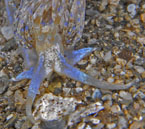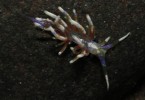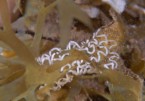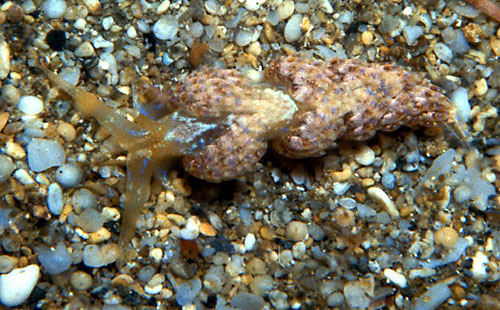| Home |
| Acknowledgments |
| Conventions |
| Glossary |
| Maps |
| References |
| Links |
| Articles |
| Thumbnails |
| Species
list |
| Family |
| Next
species |
Additional Photos

pale

side

head

spread cerata

young, 5.5 mm

mating

probable egg mass

Godiva sp. #1

| Maximum size: 35 mm (Gosliner,
et. al., 2008). Identification: This species has a translucent-cream body frosted with orange-brown flecks and with white patches that show blue iridescence in strong light. The cerata are numerous and slender with red-brown bases. They are frosted with cream apically and have one or more iridescent blue bands. Young animals have far fewer cerata and more white pigment on the cephalic tentacles. Natural history: Godiva sp. #1 is a moderately rare aeolid on Maui found in Halimeda kanaloana beds at depths of 10-12 m (33-39 ft). However, on Oahu and Midway it has also been recorded from floating docks (thermal pollution tables at Coconut Island) and more exposed rubble habitats at depths up to 20 m (66 ft). (Gosliner, 1980). It appears to be diurnally active and "flares" its cerata when disturbed. It lays an irregular, 'kinked" spiral egg mass that varies from pale pink to white, probably during the course of development. Distribution: Big Island, Maui, Oahu, Kauai and Midway. Taxonomic notes: It was probably first recorded in Hawaii from Oahu by Paul Zahl in 1959. It's listed in Gosliner, 1980 as Godiva quadricolor (Barnard, 1927). Photo: Scott Johnson: about 16 mm: Pupukea, Oahu; Aug. 19, 1985. Observations and comments: Note 1: On July 16, 2021 Virginia Armstrong recorded a video of a mating pair. As with most aeolids, the event was brief with the lower animal apparently inseminating the upper one around five seconds after first contact and the upper animal recoiling strongly immediately afterward (and, even more strongly on second contact a few seconds later). (see screen grab of pair immediately after withdrawal) |
| Thumbnails |
Species
list |
Family | Next species | Top |